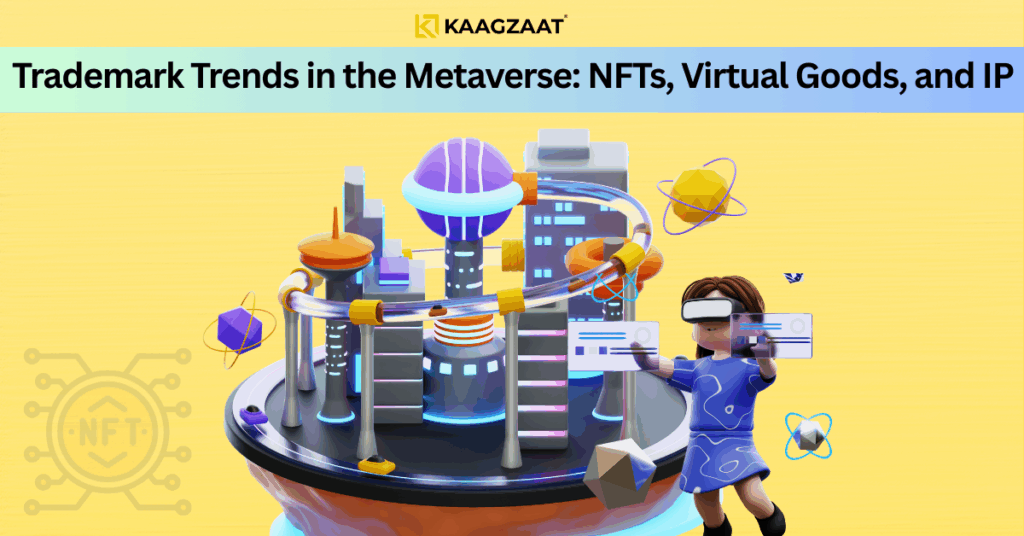Trademark Trends in the Metaverse: NFTs, Virtual Goods, and IP

The metaverse has emerged as a next-generation digital frontier where real commerce, gaming, socializing, and creativity converge. Fueled by NFTs and virtual goods, it offers vast opportunities—and creates serious intellectual property (IP) challenges for businesses, creators, and legal professionals navigating a borderless, immersive online landscape. As brands flock to protect their assets in this new domain, understanding the latest trademark trends is crucial for sustainable digital success.
Why Are Trademarks Critical in the Metaverse?
Trademarks aren’t just for physical goods anymore. Today, they:
-
Safeguard virtual fashion, avatars, collectibles, event spaces, and branded NFTs.
-
Differentiate authentic brands from counterfeits in global, real-time digital marketplaces.
-
Protect reputation and consumer trust as major brands launch virtual stores, games, and collectibles.
A single infringement can go viral, diluting brand value and creating confusion among millions of users across platforms.
NFTs, Virtual Goods, and Brand Protection
The NFT Explosion
Non-fungible tokens (NFTs) have revolutionized ownership and trade of digital items—art, music, movies, and now, branded fashion, accessories, game assets, real estate, and more. Major brands use NFTs to launch:
-
Collectible drops (e.g., virtual sneakers)
-
Access tokens for events
-
Exclusive avatars and wearables
But NFTs also make brand misuse extraordinarily easy: infringing tokens can be minted and sold from anywhere, instantly.
Legal Precedent: The MetaBirkin Case
A key turning point—the Hermès vs. MetaBirkin dispute, where a digital artist was sued for selling NFT “Birkin bags” without authorization. Courts held that unauthorized use of a registered mark in NFT environments is actionable infringement, setting a global precedent for brands to pursue digital copycats.
Virtual Goods as “Goods” for Trademark Law
Recent US, EU, and Indian cases affirm that NFTs and other virtual items are considered “goods” under trademark law. Trademark owners now routinely:
-
Register marks in classes covering downloadable digital files, NFTs, and virtual goods
-
Update portfolios to include service categories for virtual environments.
Top Challenges for Brands in the Metaverse
1. Jurisdiction and Enforcement
The borderless, decentralized nature of the metaverse makes legal enforcement complex:
-
Which country’s laws apply when infringement happens on decentralized platforms?
-
Brand owners must monitor multiple metaverse worlds, file complaints, and sometimes bring cases in multiple jurisdictions.
2. User-Generated Content (UGC)
UGC is both a driver and a risk:
-
Fans can create “fan art” or virtual goods featuring trademarks, sometimes inadvertently infringing.
-
Platforms must set clear IP policies, and brands need to engage—not just police—online communities.
3. Counterfeiting and Brand Dilution
With easy copying and resale of virtual goods:
-
Counterfeit items can be rapidly duplicated and distributed
-
Brands risk dilution, lost revenues, and damaged consumer trust if not vigilant.
4. Blockchain and Ownership
NFTs and blockchain technology create authenticity, but don’t always prevent trademark misuse:
-
Ownership of an NFT does not always transfer underlying trademark rights
-
Disputes can arise over who controls rights to digital collectibles or avatars.
Best Practices: Securing Trademarks for Virtual Goods and NFTs
1. Update and Expand Trademark Filings
Register marks in new classes for digital goods and downloadable media (e.g., NICE Class 9 and 42).
2. Proactive Monitoring
Deploy AI-driven monitoring and collaborate with platforms to spot and report infringements in real time.
3. Use Smart Contracts for Protection
Blockchain-based, self-enforcing agreements can automatically block or report infringement on compatible platforms.
4. Build Strong Platform Relationships
Partner with major metaverse worlds and NFT marketplaces for rapid takedown of unauthorized use.
5. Educate and Engage Creators
Publish clear brand guidelines—encouraging community creativity without misuse.
Case Study: Yuga Labs vs RR/BAYC
-
The 2025 US appeals ruling in Yuga Labs v. Ripps confirmed NFTs are protected “goods” under the Lanham Act, and the sale of confusingly similar digital collectibles was ruled trademark infringement—not shielded by the First Amendment.
-
Key lesson: Brands must act quickly, register their marks for virtual goods, and pursue infringement both legally and technically for robust protection.
Protecting IP Beyond Trademarks: Copyright, Designs, Patents
- Copyrights: Protect original art, software, audiovisual assets used in NFTs or virtual products.
- Designs: Register unique avatar, fashion, or interface designs to prevent imitation.
- Patents: As tech advances, patenting unique metaverse platforms, blockchain protocols, or AR/VR features can offer a competitive edge (consult IP counsel for eligibility).
The Future: Global Cooperation & New Legal Frameworks
As metaverse adoption grows, expect:
-
International treaties and harmonized virtual IP laws.
-
Platform-driven governance: Major platforms standardizing enforcement and dispute resolution.
-
Use of AI and blockchain for rights management, verification, and detection of unauthorized content.
Conclusion
As the lines blur between the physical and digital worlds in 2025, protecting trademarks and intellectual property is more critical—and more challenging—than ever. For startups, brands, and creators, a proactive, collaborative, and tech-enabled approach is essential for success in the metaverse.
Trademark Trends in the Metaverse: NFTs, Virtual Goods, and IP
Top 100 Business Ideas In India
Legal Age of Marriage in India (2025): A Clear & Updated Guide
How to Get ESIC Insurance Number in India (2025): Complete Guide
Section 142(1) Income Tax Notice: Meaning, Key Points, Documents & Reply Format
Revised TDS Return Filing in India (2025): Step-by-Step Guide
GST on Gold in India: Updated Rates for Jewellery, Coins, Bars & Biscuits
How to Verify FSSAI License Number Online in 2025: Step-by-Step Guide
Google Pay Daily Transaction Limit in India (2025): Amount, Number & Bank Rules
Trademark Class 45: Legal, Security & Personal Services
